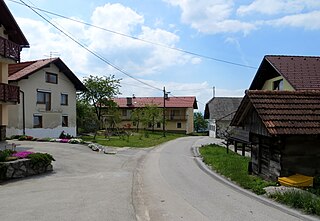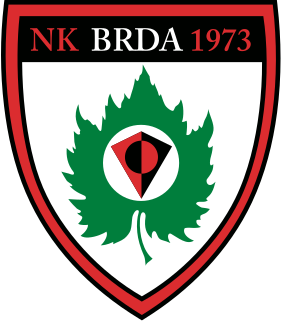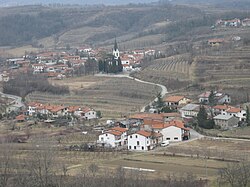
Nogometno društvo Gorica, commonly referred to as ND Gorica or simply Gorica, is a Slovenian football club playing in the town of Nova Gorica. They are one of the most successful Slovenian clubs with four Slovenian PrvaLiga and three Slovenian Cup titles. Together with Maribor and Celje, they are the only club that have participated in every season of the Slovenian PrvaLiga since its formation in 1991. The club plays its matches at the Nova Gorica Sports Park stadium with the capacity of 3,100 seats.

Nova Gorica Sports Park is a multi-purpose sports venue in Nova Gorica, Slovenia. It is currently used mostly for football matches and is the home ground of ND Gorica. The stadium was built in 1964 and has a capacity of 3,100 seats.

Ozeljan is a village in the lower Vipava Valley in western Slovenia. It is part of the Municipality of Nova Gorica in the Gorizia region of the Slovenian Littoral.

Banjšice is a settlement in western Slovenia in the Municipality of Nova Gorica. It has a population of 264. It is located on the high Banjšice Plateau, overlooking the Soča Valley. It is made up of several hamlets, including Breg, Lohke, Ošlakarji, Mrcinje, Trušnje, Podlešče, Raven, Kuščarji, and Krvavec.

Loke is a dispersed settlement in the Municipality of Nova Gorica in western Slovenia. It is located on the lowest edge of the Vipava Valley, just beneath the high Trnovo Forest Plateau. It is a satellite settlement of Kromberk, one of the four suburbs of Nova Gorica.

Lokovec is a dispersed settlement in western Slovenia in the Municipality of Nova Gorica. It is located on the Banjšice Plateau overlooking the narrow Čepovan Valley, which divides it from the Trnovo Forest Plateau on the other side of the valley. It is part of the Gorizia region.

Lokve is a village in western Slovenia in the Municipality of Nova Gorica. It is located in the Trnovo Forest, above the Vipava Valley in the Gorizia region of the Slovene Littoral. It is a popular tourist center, serving as a summer resort for people from the towns of Nova Gorica and Gorizia (Italy). Škol Hill rises north of Lokve.

Osek is a village in western Slovenia in the Municipality of Nova Gorica. It is located in the Vipava Valley in the Gorizia region of the Slovene Littoral.

Preserje is a village in western Slovenia in the Municipality of Nova Gorica. It has a population of 457. It is located in the low hills above the settlement of Branik in the Vipava Valley.

Ravnica is a village in western Slovenia in the Municipality of Nova Gorica. It is located on the high Trnovo Forest Plateau, overlooking the villages of Grgar and Čepovan.

Solkan is a settlement in the City Municipality of Nova Gorica in the Gorizia region of western Slovenia, at the border with Italy. Although it forms a single urban area with the city of Nova Gorica today, it has maintained the status of a separate urban settlement due to its history and the strong local identity of its residents.

Tabor is a village in western Slovenia in the Municipality of Nova Gorica. It is located on a small hill overlooking the Vipava Valley. The name comes from the Slovene term tabor, denoting a fortified church or village. The village was fortified in the 16th century as a defense against the Ottoman raids. Part of the fortifications are still visible today.

Vitovlje is a small village above Šempas in the Municipality of Nova Gorica in western Slovenia. It is located in the lower Vipava Valley in the Gorizia region of the Slovene Littoral.

Prvačina is a village in the Vipava Valley in western Slovenia. It lies within the Municipality of Nova Gorica.

Zalošče is a village in western Slovenia in the Municipality of Nova Gorica. It is located in the lower Vipava Valley in the Gorizia region of the Slovene Littoral.

Kostanjevica Monastery is a Franciscan monastery in Pristava near Nova Gorica, Slovenia. The locals frequently refer to it simply as Kapela.

Nova Vas is a village in the hills south of Višnja Gora in the Municipality of Ivančna Gorica in central Slovenia. The area is part of the historical region of Lower Carniola. The municipality is now included in the Central Slovenia Statistical Region.

Nogometni klub Brda Dobrovo, commonly referred to as NK Brda or simply Brda, is a Slovenian football club from Dobrovo. The team currently plays in the Slovenian Second League. The club was founded in 1973.
The 2014 Slovenian Supercup was the tenth edition of the Slovenian Supercup, an annual football match contested by the winners of the previous season's Slovenian PrvaLiga and Slovenian Cup competitions. The match was played on 13 August 2014 at the Nova Gorica Sports Park stadium in Nova Gorica between the 2013–14 Slovenian Cup winners Gorica and the 2013–14 Slovenian PrvaLiga winners Maribor.






















